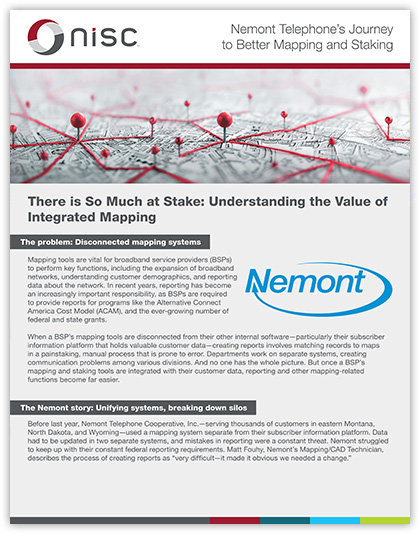The problem: Disconnected mapping systems
Mapping tools are vital for broadband service providers (BSPs) to perform key functions, including the expansion of broadband networks, understanding customer demographics, and reporting data about the network. In recent years, reporting has become an increasingly important responsibility, as BSPs are required to provide reports for programs like the Alternative Connect America Cost Model (ACAM), and the ever-growing number of federal and state grants.
When a BSP’s mapping tools are disconnected from their other internal software—particularly their subscriber information platform that holds valuable customer data—creating reports involves matching records to maps in a painstaking, manual process that is prone to error. Departments work on separate systems, creating communication problems among various divisions. And no one has the whole picture. But once a BSP’s mapping and staking tools are integrated with their customer data, reporting and other mapping-related functions become far easier.
 |
| Click here to download |
The Nemont story: Unifying systems, breaking down silos
Before last year, Nemont Telephone Cooperative, Inc.—serving thousands of customers in eastern Montana, North Dakota, and Wyoming—used a mapping system separate from their subscriber information platform. Data had to be updated in two separate systems, and mistakes in reporting were a constant threat. Nemont struggled to keep up with their constant federal reporting requirements. Matt Fouhy, Nemont’s Mapping/CAD Technician, describes the process of creating reports as “very difficult—it made it obvious we needed a change.”
All that changed when Nemont took the leap with an integrated mapping and staking solution, outlined below. With a year of integration under their belt, Nemont is already finding many previously difficult functions faster and easier:
- Federal reporting. For state and federal grants, frequent reports are necessary, and mistakes can result in fines or disqualification. Tina Palm, Senior Central Operations Manager, says that reporting had become a bad word at Nemont in the last two years as regulatory changes increased reporting requirements and made them more complicated. “The only thing worse than no data is bad data,” she says, but integrating mapping and staking tools with Nemont’s subscriber information platform is already saving time and money. Creating reports is far faster, so the company is less burdened by reporting demands. And because Nemont has honed their mapping and staking tools, they trust that the information they access is accurate every time. “It gives me a level of confidence I didn’t have before,” says Matt Fouhy.
- Engineering workflows. With integrated mapping and staking, Nemont has implemented new workflows for their engineering groups. Construction, right of way, field technicians and more are now working from the same environment as Nemont’s customer service team and other departments. Now, when a customer calls with a service request that requires the engineering team, customer service representatives can track the request as it progresses. The service request is delivered seamlessly to the engineering team. With engineering maps integrated into Nemont’s subscriber information platform, everyone on the Nemont team has visibility into the real-time status of engineering tickets. Steph Farris, Nemont’s Service Delivery Supervisor, describes this as plugging “black holes” that information fell into in the past.
- Answering FCC challenges. When customers or other providers file challenges with the FCC about Nemont’s ability to provide high-speed service to a particular address or neighborhood, Nemont can answer those challenges faster and simpler than they could before. “We can get the data much more quickly,” says Tina Palm, “and that visibility and confidence came directly from the integration of mapping.”
These are just a few examples of how NISC’s integrated Mapping and Staking solution is helping Nemont’s staff identify bottlenecks and solve longstanding problems. The unified system gives the whole team more visibility, so everyone can help create solutions that seemed impossible in the past. Integrated mapping tools enable the Nemont team to break down interdepartmental communication barriers that have existed for years.
Ensure the right integration by working with a true partner
Integrating mapping tools with your other systems shouldn’t involve sacrificing your processes or your company’s needs. Finding a partner who understand your business’ unique needs and responds as a true partner is vital to a successful integration.
Initially, Nemont was skeptical about leaving their mapping vendor behind and integrating mapping tools with their other systems. They knew switching their mapping software would take an organizational commitment, and hard work would be required to ensure the data was correct after the transfer.
Nemont has been an NISC partner for decades, using NISC’s Service solution, a robust subscriber information platform, for billing, autoprovisioning, customer data, and other key functions. Over the years, the relationship has remained solid as Nemont looks to NISC not as a vendor, but a partner that believes Nemont’s success is their success. Tina Palm describes Nemont’s partnership with NISC as critical to the success of the mapping/subscriber information integration: “It was terrifying to us, as an organization, to approach [integrating our] mapping and staking. But we knew we could count on the educated and experienced staff from NISC when there were problems. They engaged with us at a technical level, and together we knew we would make it work. It’s all hands on deck when you call them. You don’t feel like they have ten thousand customers—you feel like you’re it.”
As Nemont explored the opportunities with NISC’s Mapping and Staking—and ultimately decided to integrate them with the NISC Service solution—their priority was ensuring NISC’s tools worked exactly as Nemont needed them to. Over the year that Nemont has worked with NISC to integrate Mapping and Staking, Matt Fouhy says he has entered 108 support tickets for NISC and received 108 responses—“and that doesn’t count the side work and advice I’ve gotten from my direct contact at NISC.” Nemont values having a partner that is willing to shape the mapping and staking tools to make sure they’re not just a one-size-fits-all offering but are specifically tailored for Nemont’s particular situation. “You have the opportunity to help shape the product to make it what you want it to be,” says Tina Palm.
The future of integrated mapping and staking
Using mapping and staking tools to create reports, improve engineering workflows, and answer FCC challenges is just the start for Nemont. They view the link between the NISC Service solution and and the new mapping and staking tools as a foundation on which they can build. “Now that we’ve integrated our mapping,” says Tina Palm, “it feels like the potential is unlimited.” In the future, Nemont looks forward to leveraging the NISC Mapping and Staking solution for additional value, including:
- Funding, planning, and deploying future fiber projects: Anyone who has worked on a fiber project—from funding to planning and construction—knows how complex it can be. Using integrated mapping and staking tools, Nemont expects they will be able to leverage demographic, connectivity, and other data about areas slated for future fiber expansion as they seek funding for those projects. Planning and deployment will be smoother, as network infrastructure is integrated with detailed maps at the level of individual poles, residences, and businesses. Mapping tools will help increase the speed to market, resulting in higher overall customer satisfaction.
- Outage management: BSPs are rarely credited for their 99.999% uptime, but they’re often judged by how they perform when there’s a service interruption. Combining mapping tools with a powerful outage management system, Nemont expects to have a visual view of service outages so they can notify the right customers and send crews to the right location to fix the problem. This will save time and money, and will reinforce Nemont’s reputation for excellence and reliability in their service area.
- Marketing: When you expand your fiber network to new areas, keeping underserved customers—who will benefit from your new service—informed is a must. But it’s equally important to send the right messages to the right people at the right time. If you tell people about a new service too early, you frustrate potential customers who grow tired of waiting. But if you let them know too late to get connected easily, because construction crews have left the neighborhood, you lose revenue and increase the difficulty of installation. Integrated mapping will allow Nemont’s marketing team to have confidence about when service will be available in a particular area, so they can market to potential customers at the perfect moment.
Fully integrated mapping and staking tools add a visual dimension to your subscriber information systems that creates efficiencies and breaks down silos for everyone in your organization. When these tools are disconnected from your other software systems, you are liable to waste time by duplicating work and making costly mistakes.
If you have questions about integrated mapping and staking, don’t hesitate to reach out to NISC at 866.999.6472.
